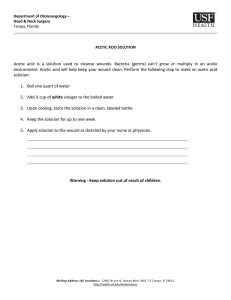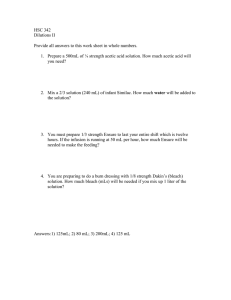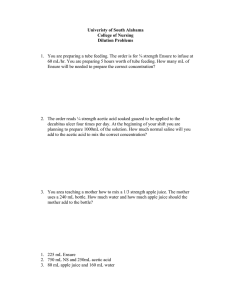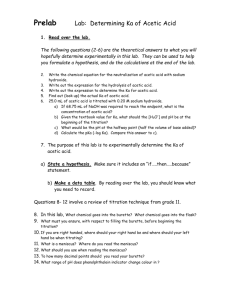Acetic acid
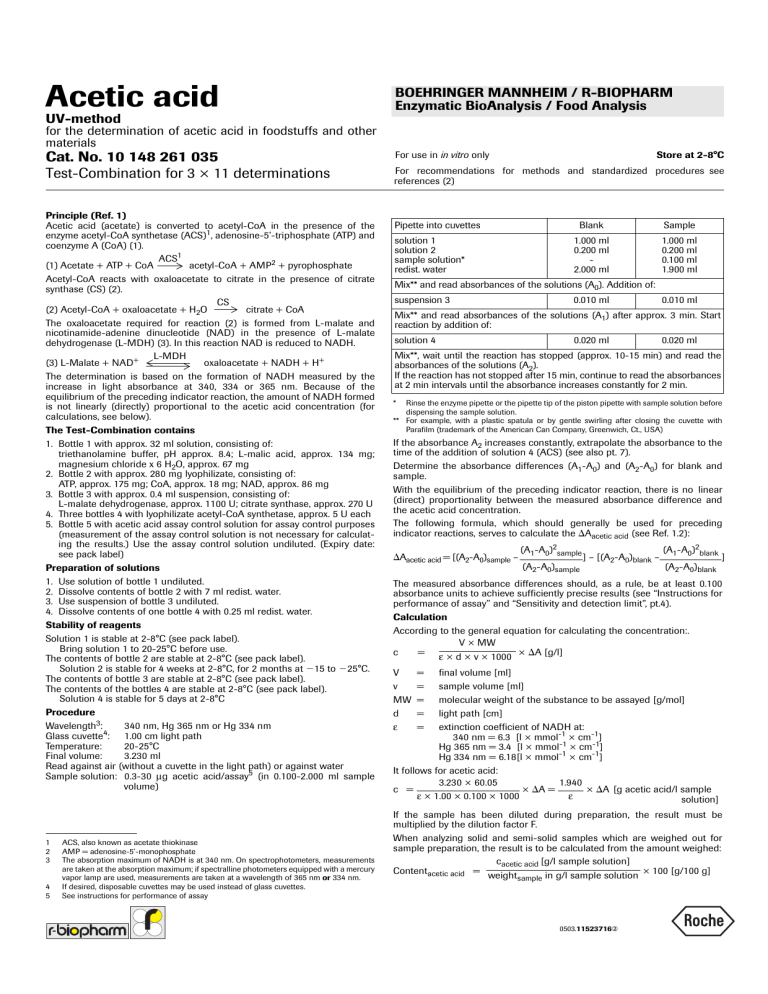
Acetic acid
UV-method for the determination of acetic acid in foodstuffs and other materials
Cat. No. 10 148 261 035
Test-Combination for 3 × 11 determinations
BOEHRINGER MANNHEIM / R-BIOPHARM
Enzymatic BioAnalysis / Food Analysis
For use in in vitro only Store at 2-8°C
For recommendations for methods and standardized procedures see references (2)
Principle (Ref. 1)
Acetic acid (acetate) is converted to acetyl-CoA in the presence of the enzyme acetyl-CoA synthetase (ACS)
1
, adenosine-5’-triphosphate (ATP) and coenzyme A (CoA) (1).
ACS
1
(1) Acetate + ATP + CoA acetyl-CoA + AMP
2
+ pyrophosphate
Acetyl-CoA reacts with oxaloacetate to citrate in the presence of citrate synthase (CS) (2).
(2) Acetyl-CoA + oxaloacetate + H
2
O
CS citrate + CoA
The oxaloacetate required for reaction (2) is formed from L-malate and nicotinamide-adenine dinucleotide (NAD) in the presence of L-malate dehydrogenase (L-MDH) (3). In this reaction NAD is reduced to NADH.
(3) L-Malate + NAD
+
L-MDH oxaloacetate + NADH + H
+
The determination is based on the formation of NADH measured by the increase in light absorbance at 340, 334 or 365 nm. Because of the equilibrium of the preceding indicator reaction, the amount of NADH formed is not linearly (directly) proportional to the acetic acid concentration (for calculations, see below).
The Test-Combination contains
1. Bottle 1 with approx. 32 ml solution, consisting of: triethanolamine buffer, pH approx. 8.4; L-malic acid, approx. 134 mg; magnesium chloride x 6 H
2
O, approx. 67 mg
2. Bottle 2 with approx. 280 mg lyophilizate, consisting of:
ATP, approx. 175 mg; CoA, approx. 18 mg; NAD, approx. 86 mg
3. Bottle 3 with approx. 0.4 ml suspension, consisting of:
L-malate dehydrogenase, approx. 1100 U; citrate synthase, approx. 270 U
4. Three bottles 4 with lyophilizate acetyl-CoA synthetase, approx. 5 U each
5. Bottle 5 with acetic acid assay control solution for assay control purposes
(measurement of the assay control solution is not necessary for calculating the results.) Use the assay control solution undiluted. (Expiry date: see pack label)
Preparation of solutions
1. Use solution of bottle 1 undiluted.
2. Dissolve contents of bottle 2 with 7 ml redist. water.
3. Use suspension of bottle 3 undiluted.
4. Dissolve contents of one bottle 4 with 0.25 ml redist. water.
Stability of reagents
Solution 1 is stable at 2-8°C (see pack label).
Bring solution 1 to 20-25°C before use.
The contents of bottle 2 are stable at 2-8°C (see pack label).
Solution 2 is stable for 4 weeks at 2-8°C, for 2 months at 15 to 25°C.
The contents of bottle 3 are stable at 2-8°C (see pack label).
The contents of the bottles 4 are stable at 2-8°C (see pack label).
Solution 4 is stable for 5 days at 2-8°C
Procedure
Wavelength
3
Glass cuvette
:
4
340 nm, Hg 365 nm or Hg 334 nm
: 1.00 cm light path
Temperature:
Final volume:
20-25°C
3.230 ml
Read against air (without a cuvette in the light path) or against water
Sample solution: 0.3-30
µ g acetic acid/assay volume)
5
(in 0.100-2.000 ml sample
1 ACS, also known as acetate thiokinase
2 AMP = adenosine-5’-monophosphate
3 The absorption maximum of NADH is at 340 nm. On spectrophotometers, measurements are taken at the absorption maximum; if spectralline photometers equipped with a mercury vapor lamp are used, measurements are taken at a wavelength of 365 nm or 334 nm.
4 If desired, disposable cuvettes may be used instead of glass cuvettes.
5 See instructions for performance of assay
Pipette into cuvettes solution 1 solution 2 sample solution* redist. water
Blank
1.000 ml
0.200 ml
-
2.000 ml
Sample
1.000 ml
0.200 ml
0.100 ml
1.900 ml
Mix** and read absorbances of the solutions (A
0
). Addition of: suspension 3 0.010 ml 0.010 ml
Mix** and read absorbances of the solutions (A
1 reaction by addition of:
) after approx. 3 min. Start solution 4 0.020 ml 0.020 ml
Mix**, wait until the reaction has stopped (approx. 10-15 min) and read the absorbances of the solutions (A
2
).
If the reaction has not stopped after 15 min, continue to read the absorbances at 2 min intervals until the absorbance increases constantly for 2 min.
* Rinse the enzyme pipette or the pipette tip of the piston pipette with sample solution before dispensing the sample solution.
** For example, with a plastic spatula or by gentle swirling after closing the cuvette with
Parafilm (trademark of the American Can Company, Greenwich, Ct., USA)
If the absorbance A
2
increases constantly, extrapolate the absorbance to the time of the addition of solution 4 (ACS) (see also pt. 7).
Determine the absorbance differences (A
1 sample.
-A
0
) and (A
2
-A
0
) for blank and
With the equilibrium of the preceding indicator reaction, there is no linear
(direct) proportionality between the measured absorbance difference and the acetic acid concentration.
The following formula, which should generally be used for preceding indicator reactions, serves to calculate the A acetic acid
(see Ref. 1.2):
A acetic acid
= [(A
2
-A
0
) sample
–
(A
1
-A
0
)
2 sample
] – [(A
2
-A
0
) blank
–
(A
2
-A
0
) sample
(A
1
-A
0
)
2 blank
(A
2
-A
0
) blank
]
The measured absorbance differences should, as a rule, be at least 0.100
absorbance units to achieve sufficiently precise results (see “Instructions for performance of assay” and “Sensitivity and detection limit”, pt.4).
Calculation
According to the general equation for calculating the concentration:.
V × MW c =
ε
× d × v × 1000
× A [g/l]
V v
= final volume [ml]
= sample volume [ml] d
ε
MW = molecular weight of the substance to be assayed [g/mol]
= light path [cm]
= extinction coefficient of NADH at:
340 nm = 6.3 [l × mmol
-1
Hg 365 nm = 3.4 [l × mmol
-1
Hg 334 nm = 6.18[l × mmol
-1
× cm
-1
× cm
× cm
-1
-1
]
]
]
It follows for acetic acid: c =
3.230 × 60.05
ε
× 1.00 × 0.100 × 1000
× A =
1.940
ε
× A [g acetic acid/l sample solution]
If the sample has been diluted during preparation, the result must be multiplied by the dilution factor F.
When analyzing solid and semi-solid samples which are weighed out for sample preparation, the result is to be calculated from the amount weighed:
Content acetic acid
= c acetic acid
[g/l sample solution] weight sample
in g/l sample solution
× 100 [g/100 g]
0503.
11523716
②
1.
Instructions for performance of assay
The amount of acetic acid present in the assay has to be between 0.6
µ g and
30
µ g (measurement at 365 nm) or 0.3
µ g and 15
µ g (measurement at 340,
334 nm), respectively. In order to get a sufficient absorbance difference, the sample solution is diluted to yield an acetic acid concentration between 0.06
and 0.3 g/l or 0.03 and 0.15 g/l, respectively.
Dilution table
Estimated amount of acetic acid per liter
Dilution with water
Dilution factor F measurement at
340 or 334 nm
0.15 g
0.15-1.5 g
1.5-15 g
15 g
365 nm
0.3 g
0.3-3.0 g
3.0-30 g
30 g
-
1 + 9
1 + 99
1 + 999
1
10
100
1000
If the measured absorbance difference ( A) is too low (e.g. 0.100), the sample solution should be prepared again (weigh out more sample or dilute less strongly) or the sample volume to be pipetted into the cuvette can be increased up to 2.000 ml. The volume of water added must then be reduced so as to obtain the same final volume in the assays for sample and blank.
The new sample volume v must be taken into account in the calculation.
2.
Technical information
2.1 In the determination of acetic acid (acid samples), care should be taken that, when carrying out sample preparation and handling the sample generally, the volatile analyte is not lost. This can be avoided by alkalizing the sample; the resulting acetate is not volatile.
2.2 In carrying out the calculation, a clear indication should be given as to whether the results are to be given as acetic acid (molar mass 60.05 g/mol) or as acetate (molar mass 59.04 g/mol). (In enzymatic determinations, the acetate ion is measured.)
3.
Specificity (Ref. 1)
The method is specific for acetic acid.
In the analysis of commercial acetic acid (glacial acid), results of approx.
100% have to be expected (when producing acetic acid solutions, the volatility of acetic acid has to be taken into consideration); in the analysis of commercial water-free sodium acetate, results of 100% have to be expected because the substance absorbs moisture.
4.
Sensitivity and detection limit (Ref. 1.3)
The smallest differentiating absorbance for the procedure is 0.005 absorbance units. This corresponds to a maximum sample volume v = 2.000 ml and measurement at 340 of an acetic acid concentration of approx. 0.1 mg/l sample solution (if v = 0.100 ml, this corresponds to 1.5 mg/l sample solution).
The detection limit of 0.15 mg/l is derived from the absorbance difference of
0.010 (as measured at 340 nm) and a maximum sample volume v = 2.000 ml.
5.
Linearity
Linearity of the determination exists from 0.3
µ g acetic acid/assay (0.15 mg acetic acid/l sample solution; sample volume v = 2.000 ml) to 30
µ g acetic/ assay (0.3 g acetic acid/l sample solution; sample volume v = 0.100 ml).
6.
Precision
In a double determination using one sample solution, a difference of 0.005 to
0.010 absorbance units may occur. With a sample volume of v = 0.100 ml and measurement at 340 nm, this corresponds to an acetic acid concentration of approx. 1.5-3 mg/l. (If the sample is diluted during sample preparation, the result has to be multiplied by the dilution factor F. If the sample is weighed in for sample preparation, e.g. using 1 g sample/100 ml = 10 g/l, a difference of 0.015-0.03 g/100 g can be expected.)
The following data have been published in the literature:
CV = 0.6-1.6 % acetic acid solutions
CV = 1.5-1.8 % white wine
CV = 1.7-2.1 % red wine
CV = 2.3-2.8 % yogurt (Ref. 1.3)
Boiled finely minced pork sausage: x = 0.3 g/100 g
Tomato ketchup: r = 0.017 g/100 g
R = 0.023 g/100 g r = 0.05 g/100 g s
(r) s
(R) s
(r)
R = 0.07 g/100 g s
(R)
= ± 0.006 g/100 g
= ± 0.008 g/100 g
= ± 0.02 g/100 g
= ± 0.02 g/100 g
Bread: x = 131.89 mg/100 g r = 7.53 mg/100 g s
(r) x = 204.55 mg/100 g
R = 21.12 mg/100 g s
(R) r = 7.41 mg/100 g s
(r)
R = 19.35 mg/100 g s
(R)
= ± 2.66 mg/100 g
= ± 7.46 mg/100 g
= ± 2.62 mg/100 g
= ± 6.84 mg/100 g
(Ref. 2.1)
7.
Interference/sources of error
Esters of acetic acid may be saponified under assay conditions (examples: ethyl acetate in wine; acetyl salicylic acid in pharmaceuticals). Acetic acid formed by slow hydrolysis is responsible for creep reactions which have to be taken into consideration when calculating results (extrapolation of A
2 the time of the addition of the sample solution).
to
8. Recognizing interference during the assay procedure
8.1 If the conversion of acetic acid has been completed according to the time given under “Procedure”, it can be concluded in general that no interference has occurred.
8.2 On completion of the reaction, the determination can be restarted by adding acetic acid or sodium acetate (qualitative or quantitative): if the absorbance is altered subsequent to the addition of the standard material, this is also an indication that no interference has occurred.
8.3 Operator error or interference of the determination through the presence of substances contained in the sample can be recognized by carrying out a double determination using two different sample volumes (e.g.
0.100 ml and 0.200 ml): the measured differences in absorbance should be proportional to the sample volumes used.
When analyzing solid samples, it is recommended that different quantities
(e.g. 1 g and 2 g) be weighed into 100 ml volumetric flasks. The absorbance differences measured and the weights of sample used should be proportional for identical sample volumes.
8.4 Possible interference caused by substances contained in the sample can be recognized by using an internal standard as a control: in addition to the sample, blank and standard determinations, a further determination should be carried out with sample and assay control solution in the same assay. The recovery can then be calculated from the absorbance differences measured.
8.5 Possible losses during the determination can be recognized by carrying out recovery tests: the sample should be prepared and analyzed with and without added standard material. The additive should be recovered quantitatively within the error range of the method.
9.
Reagent hazard
The reagents used in the determination of acetic acid are not hazardous materials in the sense of the Hazardous Substances Regulations, the
Chemicals Law or EC Regulation 67/548/EEC and subsequent alteration, supplementation and adaptation guidelines. However, the general safety measures that apply to all chemical substances should be adhered to.
After use, the reagents can be disposed of with laboratory waste, but local regulations must always be observed. Packaging material can be disposed of in waste destined for recycling.
2
10. General information on sample preparation
In carrying out the assay:
Use clear, colorless and practically neutral liquid samples directly, or after dilution according to the dilution table, and of a volume up to 2.000 ml;
Filter turbid solutions ;
Degas samples containing carbon dioxide (e.g. by filtration);
Adjust acid samples to approx. pH 8-9 by adding sodium or potassium hydroxide solution;
Adjust acid and weakly colored samples to pH 8-9 by adding sodium or potassium hydroxide solution and incubate for approx. 15 min;
Treat “strongly colored” samples that are used undiluted or with a higher sample volume with activated charcoal or with polyamide or polyvinylpolypyrrolidone (PVPP), e.g. 1 g/100 ml;
Crush or homogenize solid or semi-solid samples, extract with water or dissolve in water and filter if necessary; resp. remove turbidities or dyestuffs by Carrez clarification;
Deproteinize samples containing protein with perchloric acid; alternatively clarify with Carrez reagents;
Extract samples containing fat with hot water (extraction temperature should be above the melting point of the fat involved). Cool to allow the fat to separate, make up to the mark, place the volumetric flask in an ice bath for 15 min and filter; alternatively clarify with Carrez-solutions after the extraction with hot water.
Carrez clarification:
Pipette the liquid sample into a 100 ml volumetric flask containing approx.
60 ml redist. water, or weigh sufficient quantity of the sample into a 100 ml volumetric flask and add approx. 60 ml redist. water. Subsequently, carefully add 5 ml Carrez-I-solution (potassium hexacyanoferrate(II) (ferrocyanide),
85 mM = 3.60 g K
4
[Fe(CN)
6
] × 3 H
2
O/100 ml) and 5 ml Carrez-II-solution
(zinc sulfate, 250 mM = 7.20 g ZnSO
4
× 7 H
2
O/100 ml). Adjust to pH 7.5-8.5
with sodium hydroxide (0.1 M; e.g. 10 ml). Mix after each addition. Fill the volumetric flask to the mark, mix and filter.
11. Application examples
Determination of acetic acid in fruit juices a) Fruit juices with a high acetic acid content (for example, in the range of approx. 0.3 g/l): Dilute the sample with water 1 + 1; use 0.100 ml for the assay.
b) Fruit juices with a low acetic acid content (less than approx. 0.02 g/l):
Decolorize colored juices :
Add 1% (w/v) activated charcoal to the sample, stir for approx. 30s and filter.
Use 0.500 ml for the assay (take into account the altered sample volume v in the calculation).
In certain situations (when using a large sample volume), adjust acid juices to pH 8.
Determination of acetic acid in wine (Ref. 3.1)
Use 0.100 ml of white wine undiluted for the assay (this volume may be increased up to 2.000 ml, if necessary).
Use 0.100 ml of red wine containing about 0.2 g of acetic acid/l undiluted for the assay without decolorizing.
To red wine containing less than 0.1 g acetic acid/l add 1% (w/v) polyamide or PVPP, stir for approx. 1 min and filter. Adjust an aliquot volume of the largely decolorized sample to pH 8 (indicator paper) with sodium hydroxide
(0.1 M), dilute with water to give double the volume. Use up to 2.000 ml, if necessary, for the assay (take into account the dilution and the altered sample volume v in the calculations).
High alcohol concentrations in the sample may delay the acetate reaction.
The absorbances A
2
should therefore be read after 20 min.
Determination of acetic acid in vinegar
Dilute the sample according to the dilution table and use 0.100 ml for the assay.
Determination of acetic acid in sour dressings and sauces
Separate solids from the sample and place it into a refrigerator for 20 min to obtain separation of fat. Filter, adjust filtrate to 20-25°C and dilute according to the dilution table, if necessary.
Determination of acetic acid in beer (Ref. 3.4, 3.5)
To remove the carbonic acid stir approx. 5-10 ml of beer for 30s with a glass rod or filter. The largely CO
2
-free sample is used for the assay without further dilution.
Determination of acetic acid in hard cheese
Accurately weigh approx. 2 g of ground cheese into a 100 ml volumetric flask, add about 70 ml water and incubate at approx. 60°C for 20 min. Shake flask from time to time. After cooling to 20-25°C, fill up to 100 ml with redist.
water. For separation of fat, place the flask in a refrigerator for 20 min, filter, discard the first few ml of the filtrate. Use the clear solution, which may also be slightly opalescent, adjusted to 20-25°C, for the assay.
Determination of acetic acid in mayonnaise or yogurt
Accurately weigh approx. 5 g of sample into a 100 ml volumetric flask, add approx. 50 ml redist. water and heat for 20 min in a waterbath at 50-60°C; shake from time to time. After cooling to 20-25°C, fill up to 100 ml with redist. water. For separation of fat, place the mixture for 20 min in a refrigerator. Filter solution and use the clear or slightly turbid solution, adjusted to 20-25°C for the assay.
Determination of acetic acid in meat products
Accurately weigh approx. 10 g minced sausage and homogenize with 80 ml perchloric acid (1 M) for 10 min using a homogenizer (Ultra Turrax, or IKA mill), centrifuge, decant the supernatant, and filter. Discard the first few ml of the filtrate and pipette 20 ml into a beaker, adjust to pH 10.0 with potassium hydroxide (2 M); measure the volume of KOH. To obtain quantitative precipitation of the potassium perchlorate formed, place in an ice-bath or refrigerator for 20 min; filter. Use the clear solution diluted, if necessary (see dilution table), for the assay. When calculating the dilution, take into account the water content of the sample.
For calculating the content (in g/100 g) according to the above-mentioned formula (see calculation) the content of the sample in the sample solution is needed. When applying the above-mentioned sample preparation and considering the water content of the sample the weight of the sample is calculated according to the following formula:
Weight sample
= a × 1000 × d
(b + a × w) × (d + e)
[g/l]
It is: a: b: d: e: w: the weighed sample in g volume of perchloric acid in ml volume of the aliquot of supernatant in ml volume of KOH for neutralization in ml water content of the sample in (%; w/w)/100
1000: factor for g expressed in mg
(The specific gravity of water from the sample at 20-25°C is approx. 1 g/ml. It can be neglected for the calculation.)
12. Further applications
The method may also be used in the examination of paper, pharmaceuticals
(e.g. infusion solutions, acetyl salicylic acid preparations), emulsifiers (after alkaline hydrolysis) and in research when analyzing biological samples.
For details of sampling, treatment and stability of the sample see Bergmeyer,
H. U. & Möllering, H. (1974) in Methods of Enzymatic Analysis (Bergmeyer, H.
U., ed.) 2nd ed., vol. 3, p. 1523-1525, Verlag Chemie, Weinheim/Academic
Press, Inc. New York and London; Holz, G. & Bergmeyer, H. U. (1974) in
Methods of Enzymatic Analysis (Bergmeyer, H. U., ed.) 2nd ed., vol. 3, p.
1530, Verlag Chemie, Weinheim/Academic Press, Inc. New York and London;
Lundquist, F. (1974) in Methods of Enzymatic Analysis (Bergmeyer, H. U., ed.)
2nd ed., vol. 3, p. 1534-1535, Verlag Chemie, Weinheim/Academic Press, Inc.
New York and London.
Determination of acetic acid in fermentation samples and cell culture media
Place the sample, after centrifugation, if necessary, in a water-bath of 80°C
(cover the tube because of the volatility of acetic acid) to stop enzymatic reactions. Centrifuge and use the supernatant, diluted according to the dilution table, if necessary, for the assay. (Alternatively, deproteinization can be carried out with perchloric acid. See the abovementioned examples.)
Homogenize gelatinous agar media with water and treat further as described.
3
References
1.1
1.2
1.3
2.1
2.2
2.3
2.4
2.5
2.6
Bergmeyer, H. U. & Möllering, H. (1974) in Methoden der enzymatischen Analyse
(Bergmeyer, H. U., Hrsg.) 3. Aufl., Bd. 2, S. 1566-1574; Verlag Chemie, Weinheim, and
(1974) in Methods of Enzymatic Analysis (Bergmeyer, H. U., ed.) 2nd. ed., vol. 3, p. 1520-
1528, Verlag Chemie, Weinheim/Academic Press, Inc. New York and London
Bergmeyer, H. U. (1974) in Methoden der enzymatischen Analyse (Bergmeyer, H. U.,
Hrsg.) 3. Aufl., Bd. 1, S. 119-125; Verlag Chemie, Weinheim and (1974) in Methods of
Enzymatic Analysis (Bergmeyer, H. U., ed.) 2nd ed., vol. 1, p. 112-117, Verlag Chemie,
Weinheim/Academic Press, Inc. New York and London
Beutler, H.-O. (1984) in Methods of Enzymatic Analysis (Bergmeyer, H. U., ed.) 3rd ed., vol. VI, pp. 639-645, Verlag Chemie, Weinheim, Deerfield Beach/Florida, Basel
Amtliche Sammlung von Untersuchungsverfahren nach §35 LMBG; Untersuchung von
Lebensmitteln: Bestimmung von Essigsäure (Acetat) in Fleischerzeugnissen, 07.00-14
(November 1981); Bestimmung von Essigsäure (Acetat) in Wurstwaren, 08.00-16
(November 1981); Bestimmung der Essigsäure in Tomatenketchup und vergleichbaren
Erzeugnissen, 52.01.01-16 (November 1983); Bestimmung von Essigsäure (Acetat) in
Brot einschließlich Kleingebäck aus Brotteigen, 17.00-16 (Juni 1990)
Gombocz, E., Hellwig, E., Vojir, F. & Petuely, F. (1981) Deutsche Lebensmittel-Rundschau,
77, 13-14
Brautechnische Analysenmethoden, Band III, S. 568-572 (1982), Methodensammlung der Mitteleuropäischen Brautechnischen Analysenkommission (MEBAK), herausgegeben von F. Drawert im Selbstverlag der MEBAK, Freising
Niederlande: Warenwet, Uitvoeringsvoorschriften (C II-6), Regeling Onderzoekingsmethoden voor brood; Methode 16: De Bepaling van Calciumacetat (Oktober 1986); Dit voorschrift betrijft een methode voor de bepaling van calciumacetat in het in brood verwerkte meel
Deutsche Norm DIN EN ISO 11213 (April 1995) Modifizierte Stärke - Bestimmung des
Acetylgehaltes - Enzymatisches Verfahren (ISO 11213:1995) Deutsche Fassung EN ISO
11213:1995 Modified Starch - Determination of acetyl content - Enzymatic method
European Standard EN ISO 11213 (April 1995) Modified Starch - Determination of acetyl content - Enzymatic method
2.7
2.8
International Federation of Fruit Juice Producers (IFU, Methods of Analysis, no. 66-
1996)
Deutsche Norm DIN EN 12632 (April 1999) Frucht- und Gemüsesäfte; Enzymatische
Bestimmung des Gehaltes an Essigsäure (Acetat); Spektralphotometrische Bestimmung von NAD
2.9
Europäische Norm / European Standard EN 12632 (April 1999) , Frucht- und Gemüsesäfte: Enzymatische Bestimmung des Gehaltes an Essigsäure (Acetat) - Spektralphotometrische Bestimmung von NAD (Fruit and vegetable juices - Enzymatic determination of acetic acid (acetate) content - NAD spectrometric method)
2.10
Deutsche Norm DIN 10 370 (Juni 1998) Material zur Herstellung von Umhüllungen für
Zigarettenfilter, Zigaretten und andere Tabakerzeugnisse, Bestimmung des Acetatgehaltes
3.1
Junge, Ch. & Spadinger, Ch. (1979) Die flüchtigen Säuren des Weines, Deutsche
Lebensmittel-Rundschau 75 , 12-15
3.2
3.3
3.4
3.5
3.6
Müller, H. & Horbach, A. (1981) Bestimmung von Acetylendgruppen in Polycaprolactam durch Hydrolyse und enzymatische Essigsäure-Analyse, Die Angewandte
Makromolekulare Chemie 96, 37-41
Spicher, G. & Rabe, E. (1981) Die Mikroflora des Sauerteiges; XII. Mitteilung: Der Einfluss der Temperatur auf die Lactat-/Acetatbildung in mit homofermentativen Milchsäurebakterien angestellten Sauerteigen, Z. Lebensm. Unters. Forsch. 172, 20-25
Piendl, A. & Wagner, I. (1983) Physiologische Eigenschaften der organischen Säuren des Bieres; l. Acetat, Brauindustrie 68, 862-866
Klopper, W, J., Angelino, S.A.G.F., Tuning, B. & Vermeire, H.A. (1986) Organic acids and glycerol in beer, J. Inst. Brew. 92, 225-228
Saalfeld, U. & Freund, W. (1999) Charakterisierung pulverisierter Sauerteige und Möglichkeiten ihrer qualitativen Bestimmung im Brot - Teil II: Untersuchung der Acetat-,
Lactose-, Hexanal-, Calcium-, Kalium- und Natriumgehalte und der Thiobarbitursäurereaktiven Substanzen, Deutsche Lebensmittel-Rundschau 95, 297-304
Acetic acid assay control solution (Bottle 5)
Concentration: see bottle label
Acetic acid assay control solution is a stabilized aqueous solution of acetic acid. It serves as an assay control solution for the enzymatic determination of acetic acid in foodstuffs and other materials.
Application:
1. Addition of acetic acid assay control solution to the assay mixture:
Instead of sample solution the assay control solution is used for the assay.
2. Restart of the reaction, quantitatively:
After completion of the reaction with sample solution and measuring of A
2 add 0.050 ml assay control solution to the assay mixture. Read absorbance
,
A
3
after the end of the reaction (approx. 20 min.). An increase of absorbance is observed.
A calculation of results is not possible because of the preceding equilibrium reaction with L-MDH (3).
3. Internal standard:
The assay control solution can be used as an internal standard in order to check the determination for correct performance (gross errors) and to see whether the sample solution is free from interfering substances:
Pipette into cuvettes solution 1 solution 2 sample solution assay control sln.
redist. water
Blank
1.000 ml
0.200 ml
-
-
2.000 ml
Sample
1.000 ml
0.200 ml
0.100 ml
-
1.900 ml
Standard
1.000 ml
0.200 ml
-
0.100 ml
1.900 ml
Sample +
Standard
1.000 ml
0.200 ml
0.050 ml
0.050 ml
1.900 ml
Mix, and read absorbances of the solutions (A
0
). Continue as described in the pipetting scheme under “Procedure”. Follow the instructions given under
“Instructions for performance of assay” and the footnotes.
The recovery of the standard is calculated according to the following formula: recovery =
2 × A sample + standard
- A sample
A standard
× 100 [%]
R-BIOPHARM AG
Landwehrstr. 54
D-64293 Darmstadt
Telefon + 49 61 51 / 81 02-0
Fax + 49 61 51 / 81 02-20 www.r-biopharm.com
